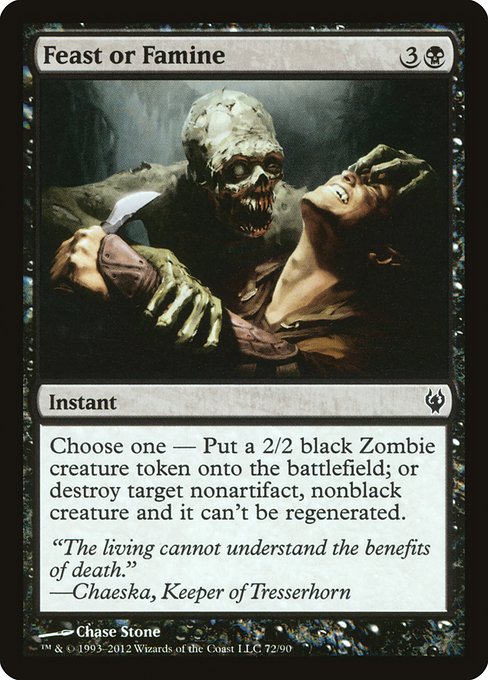
Image courtesy of Scryfall.com
Feast or Famine: How Marketplaces Shape MTG Card Prices
Online marketplaces are the hidden engine behind every card price you see on your screen 🧙♂️. They don’t just track scarcity; they orchestrate it. When a card like Feast or Famine surfaces in a duel deck from 2012, the printed copy isn’t the whole story—sellers across TCGPlayer, Cardmarket, and assorted shops worldwide create a living price floor and ceiling with every listing, restock, and stockout. The result is a price that’s less about a single rarity and more about supply chains, shipping costs, regional demand, and the occasional impulse buy from a curious EDH player hunting a multifaceted instant that can swing a board state in a heartbeat 🔥.
Feast or Famine is an Instant from Duel Decks: Izzet vs. Golgari (DDJ), with a mana cost of {3}{B} and a default rarity of common. Its two options—“Create a 2/2 black Zombie creature token” or “Destroy target nonartifact, nonblack creature. It can't be regenerated”—give players flexibility in the moment. That flexibility can be a subtle price driver in online listings: a card with two viable modes often lands in higher demand than a strictly single-purpose spell, even when the card’s raw mana value and rarity say otherwise. In a way, the market is rewarding not just power but versatility wrapped in a neat, black-minted package 🧠⚔️.
The data behind Feast or Famine in Scryfall’s ecosystem tells a quiet story: the card is printed as common in a reprint set—specifically a Duel Deck—so the supply is robust but not limitless. It’s not a staple in the modern meta, and it’s not a foil or etched rarity that pricing engines twist into a premium. The card’s USD price hovers around tiny, accessible figures (roughly a couple of quarters to a little more in USD, with EUR around a dime-level figure and TIX in the low odds of a few dimes). That baseline makes it a perfect target for online shoppers who want effect for value and sellers who want turnover: it’s easy to list, easy to ship, and easy to price competitively in a sea of low-cost black spells 🧩💎.
“The living cannot understand the benefits of death.” — Chaeska, Keeper of Tresserhorn
That flavor line feels apt when you watch markets shift around a common card with a darkly practical design. Feast or Famine thrives not on being the star of a deck but on being a dependable, flexible answer that fits into black-centric or Golgari-adjacent strategies. In commander circles, where the stack of one-liners constantly shifts and the cost of a proactive answer matters, such a card gains a second lease on life. The online marketplace amplifies that effect by aggregating demand from EDH players, casual kitchen-table play, and older-printed sets that still circulate in a curious mix of new and veteran collectors. The price you see is the product of tiered supply: paper stock turning up in bulk from old inventory, restocks that trickle in from break-open boxes, and the occasional bulk sale that nudges the price downward for a moment before the next set or reprint shifts the floor again 🔄🪙.
From a design perspective, Feast or Famine embodies a neat equilibrium: a dependable disruption spell with a convertible token option. It’s easy to price in a database because the card’s identity travels well across markets; it’s not a one-off misprint that some retailers carry in tiny numbers. The market’s tuning of this card’s price shows how non-foil, widely printed commons from older duel decks anchor secondary-market activity: steady, predictable, and occasionally spiked by offbeat collector demand when someone tries to complete a casual “black budget” deck or a Golgari-themed throwback list. The art by Chase Stone—dark, evocative, and compact—also helps a card feel collectible even at a low price point, nudging some shoppers to add it to their cart for the complete nostalgia package 🎨🧙♂️.
Retailers often balance price against turn rate. Feast or Famine’s nonfoil status, and its status as reprinted content, keep it from skyrocketing—yet the dual-mode effect ensures it remains catalogued as a legitimate, occasionally sought-after inclusion in modern playhouses and kitchen-table builds alike. The online experience, with price-compare tools and real-time inventory indicators, encourages buyers to shop around for the best deal, while sellers compete on shipping speed, packaging, and customer service. In short: the marketplaces shape not just the “how much” but the “how quickly” and “how reliably” a card will move from the cart to the inbox 📦⚙️.
What this means for collectors and players
For collectors, Feast or Famine is a touchstone of 2012-era dual decks rather than a marquee bottle-rocket of value. For players, its two options provide a low-APR opportunity to disrupt an opponent’s board while maintaining a token farm option for casual aristocrat shenanigans. The dynamic pricing you’ll observe online is a gentle reminder that MTG is as much about the story of distribution as it is about the cards on the table. Online marketplaces make price discovery a communal ritual rather than a solitary guess, and that democratic pricing is part of what keeps players engaged across formats—from Commander tables to casual Friday games 🧙♀️🎲.
If you’re browsing to enrich your desk while you read, consider a modern companion—the Neon Gaming Mouse Pad 9x7 with Custom Neoprene, Stitched Edges. It’s a small but satisfying contrast to the solemn black and red of a vampire’s lullaby, and it pairs nicely with the tactile joy of shuffling across a well-made surface during a long session. The product link is tucked below, a quiet nod to cross-promotion that doesn’t shove the promo in your face—just a friendly nudge to upgrade your battlestation while you dive into the marketplace narrative 🖱️🔥.
Neon Gaming Mouse Pad 9x7: Custom Neoprene, Stitched Edges
More from our network
- https://blog.digital-vault.xyz/blog/post/hot-reddened-star-anchored-by-parallaxes-in-a-distant-open-cluster/
- https://crypto-acolytes.xyz/blog/post/dr3-kinematics-of-a-hot-giant-at-eight-thousand-light-years/
- https://blog.rusty-articles.xyz/blog/post/seismitoad-and-the-emotional-power-of-legendary-treasures/
- https://crypto-acolytes.xyz/blog/post/what-went-wrong-in-spyro-enter-the-dragonfly/
- https://blog.crypto-articles.xyz/blog/post/warp-point-reviews-by-pokemon-influencers-and-youtubers/